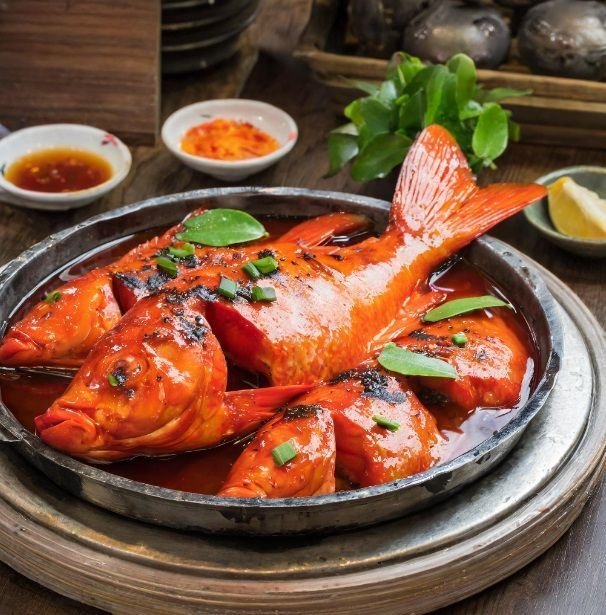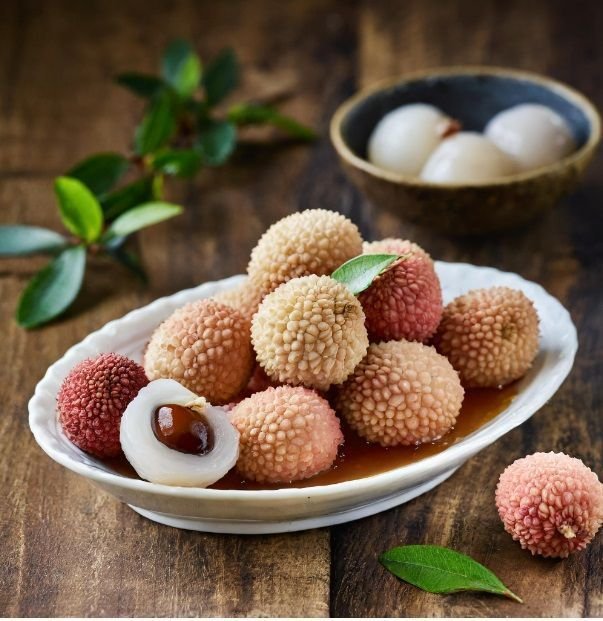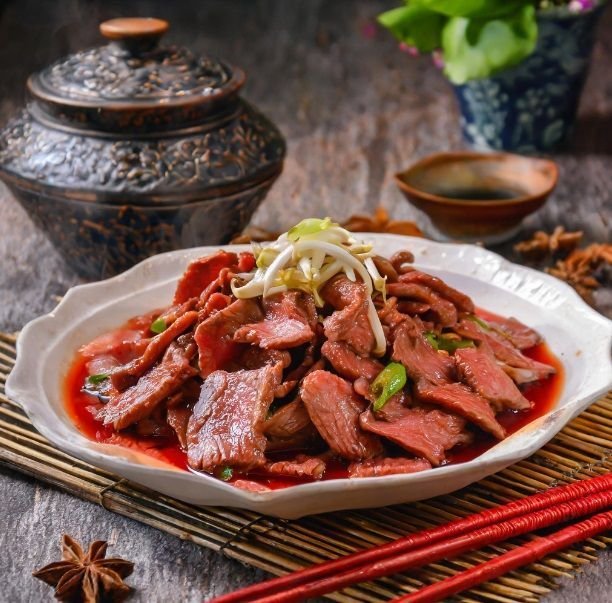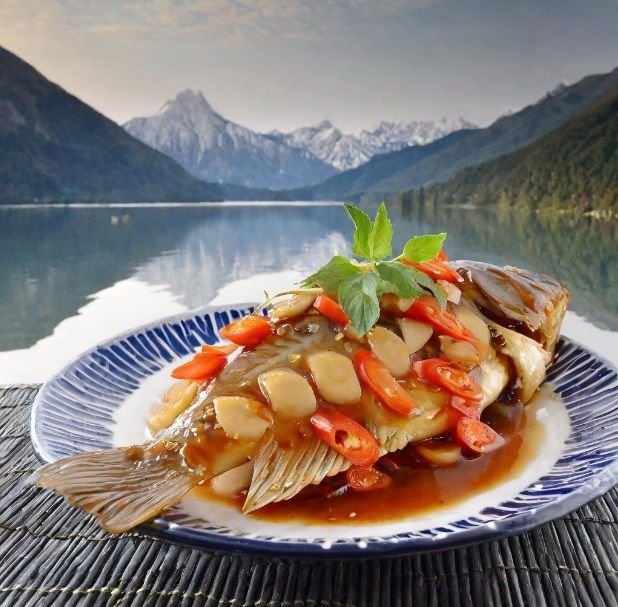Carp-Shanghai red-cooked fish
Carp-Shanghai red-cooked fish
“Shanghai Red-Cooked Fish” is a traditional dish from the Shanghai region in East China. It’s characterized by its rich, savory-sweet flavor and tender texture. Here’s a step-by-step recipe to make Shanghai Red-Cooked Fish:
Ingredients:
- 1 whole fish (such as carp fish or sea bass), cleaned and scaled
- 3 tablespoons soy sauce
- 2 tablespoons Shaoxing wine (or dry sherry)
- 2 tablespoons brown sugar (or rock sugar)
- 2 slices ginger
- 2 cloves garlic, minced
- 2 green onions, chopped
- 1 star anise
- 1 cinnamon stick
- 2-3 dried red chilies (optional)
- 2 cups water or fish stock
- 2 tablespoons vegetable oil
- Salt and pepper to taste
- Chopped green onions and cilantro for garnish
Instructions:
1. Prepare the Fish (asian carp or sea bass):
- Rinse the fish under cold water and pat dry with paper towels. Score both sides with shallow diagonal cuts to help it absorb the flavors of the sauce.
2. Marinate:
- In a bowl, mix together soy sauce, Shaoxing wine, and brown sugar until the sugar is dissolved. Pour the marinade over the fish, making sure to coat both sides evenly. Let it marinate for about 15-20 minutes.
3. Sauté Aromatics:
- Heat vegetable oil in a large skillet or wok over medium heat. Add minced garlic, chopped green onions, ginger slices, star anise, cinnamon stick, and dried red chilies (if using). Sauté until fragrant, about 1-2 minutes.
4. Cook:
- Carefully place the marinated fish into the skillet or wok. Pour in water or fish stock until it is partially submerged. Bring the liquid to a gentle simmer.
5. Simmer:
- Cover the skillet or wok and let the fish simmer gently for about 10-15 minutes, or until it is cooked through and flakes easily with a fork. Baste it occasionally with the simmering liquid to ensure even cooking and to infuse it with flavor.
6. Adjust Seasoning:
- Taste the sauce and adjust the seasoning with salt and pepper if needed. You can also adjust the sweetness by adding more brown sugar if desired.
7. Garnish and Serve:
- Once the fish is cooked, carefully transfer it to a serving platter. Spoon some of the sauce over it and garnish with chopped green onions and coriander for freshness and color.
8. Serve Hot:
- Serve the Shanghai Red-Cooked Fish hot with steamed rice and your favorite vegetables or side dishes. The flavorful sauce pairs well with the delicate taste of this ingredient.
9. Enjoy:
- Enjoy the succulent and aromatic Shanghai Red-Cooked Fish as a comforting and satisfying meal that showcases the rich culinary heritage of East China.
This dish is perfect for sharing with family and friends, and its robust flavors are sure to impress everyone at the table. Adjust the level of spiciness by adding more or fewer dried red chilies according to your taste preferences.
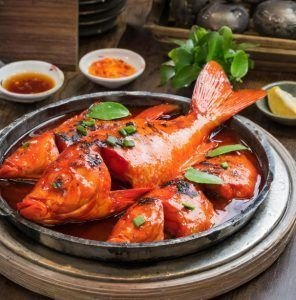
Fish in Asian Cuisine of East China: Tradition, Usage, and Culinary Significance
This ingredient holds a special place in the culinary traditions of East China, particularly in regions like Shanghai, Zhejiang, Jiangsu, and Fujian. With a rich coastline and abundant freshwater resources, East China boasts a diverse array of these species that have been integral to the region’s cuisine for centuries.
From delicate steamed fish to flavorful braised dishes, this ingredient plays a central role in East Chinese culinary culture, reflecting the region’s deep connection to its aquatic surroundings. In this article, we will explore the tradition, usage, and culinary significance of this ingredient in the Asian cuisine of East China.
1. Tradition and Cultural Significance:
- This ingredient has been a symbol of prosperity, abundance, and good fortune in Chinese culture for centuries. It is often featured in traditional Chinese New Year feasts and other festive occasions as a symbol of prosperity and wealth.
- In East China, where fishing has long been a way of life, this ingredient holds particular cultural significance. It symbolizes the region’s close relationship with its rivers, lakes, and seas, as well as its reliance on the bounty of the waters for sustenance.
- This ingredient is also associated with various auspicious meanings in Chinese culture. For example, the Chinese word for fish, “yu,” sounds similar to the word for surplus or abundance, symbolizing prosperity and surplus in the coming year.
2. Usage in East Chinese Cuisine:
- Steamed Fish: this dish is a classic in East Chinese cuisine, prized for its simplicity and delicate flavor. The fish is often seasoned with ginger, scallions, soy sauce, and Shaoxing wine before being steamed to perfection. This method preserves the natural sweetness and texture of the the ingredient.
- Red-Cooked Fish: this dish, also known as “hongshao yu,” is another popular preparation method in East Chinese cuisine. The fish is braised in a savory-sweet sauce made from soy sauce, sugar, ginger, garlic, and spices until tender and flavorful. This dish showcases the region’s love for rich, aromatic flavors.
- Sweet and Sour Fish: this dish, or “tangcu yu,” is a specialty of Zhejiang cuisine, known for its balance of sweet, tangy, and savory flavors. The fish is typically coated in a light batter, deep-fried until crispy, and then tossed in a vibrant sweet and sour sauce made from vinegar, sugar, ketchup, and spices.
- Stir-Fried Fish: this dish is a common cooking method in East Chinese cuisine, and this ingredient is often stir-fried with vegetables and aromatic seasonings to create flavorful and nutritious dishes. Fish fillets are quickly cooked over high heat with ingredients like ginger, garlic, bell peppers, and mushrooms, resulting in tender fish with vibrant flavors and textures.
3. Culinary Techniques and Preparation:
- This ingredient is often cooked whole in East Chinese cuisine, as this is believed to preserve the fish’s natural flavors and juiciness. This ingredient is typically scaled, gutted, and cleaned before being seasoned and cooked using various methods such as steaming, frying, braising, or stir-frying.
- Aromatic ingredients like ginger, garlic, scallions, and Shaoxing wine are commonly used to season and flavor fish dishes in East Chinese cuisine. These ingredients help to enhance the natural taste of the fish and create a harmonious balance of flavors.
4. Health Benefits and Nutritional Value:
- Is a highly nutritious protein source, rich in omega-3 fatty acids, vitamins, and minerals. Regular consumption of this ingredient or product is associated with various health benefits, including improved heart health, brain function, and overall well-being.
- Steamed fish, in particular, is considered a healthy and light option, as it is low in fat and calories while providing essential nutrients. The gentle cooking method helps to preserve the fish’s nutritional integrity and delicate texture.
5. Sustainability and Environmental Concerns:
- With growing awareness of environmental issues and overfishing, there is a growing emphasis on sustainable fishing practices in East China and beyond. Efforts are being made to promote responsible fishing practices, protect endangered species, and preserve marine ecosystems for future generations.
- In East Chinese cuisine, there is also a focus on using locally sourced and seasonal ingredients, including fish. This not only supports local fishermen and communities but also ensures the freshness and quality of the ingredients used in traditional dishes.
This ingredient holds a special place in the culinary traditions of East China, where it symbolizes prosperity, abundance, and good fortune. From delicate steamed fish to flavorful braised dishes, fish is prepared using various cooking methods and seasoned with aromatic ingredients to create dishes that are both nutritious and delicious.
As East Chinese cuisine continues to evolve, this ingredient remains an integral part of the region’s culinary heritage, reflecting its deep connection to its aquatic surroundings and rich cultural traditions.

Rock Sugar in Chinese Cuisine: A Sweet Tradition
Rock sugar, also known as rock candy or rock sugar crystals, is a traditional sweetener widely used in Chinese cuisine. It is made from crystallized sugar that forms naturally during the slow evaporation of sugar cane juice. In Chinese cooking, rock sugar is prized for its unique flavor, subtle sweetness, and ability to enhance both savory and sweet dishes. Let’s explore the usage of rock sugar in Chinese cuisine:
1. Sweet and Sour Sauces:
- One of the most common uses of rock sugar in Chinese cuisine is in the preparation of sweet and sour sauces. Rock sugar is melted down and combined with vinegar, soy sauce, and other seasonings to create a balanced and tangy sauce that complements dishes like sweet and sour pork, chicken, or fish.
2. Braised Dishes:
- Rock sugar is often added to braised dishes to provide a touch of sweetness and depth of flavor to the sauce. It dissolves slowly during the cooking process, infusing the dish with a subtle sweetness that helps to counterbalance the savory flavors of ingredients like meat, tofu, or vegetables.
3. Desserts and Sweet Treats:
- In Chinese desserts and sweet treats, rock sugar is a common ingredient used to sweeten dishes without overpowering them with a cloying sweetness. It is often used in recipes for traditional desserts such as sweet soups, custards, puddings, and herbal teas.
4. Herbal Medicine:
- In traditional Chinese medicine (TCM), rock sugar is believed to have medicinal properties and is used as a carrier for herbal remedies. It is often combined with various herbs and botanicals to create tonics and herbal teas that are believed to promote health and well-being.
5. Candied Fruits and Nuts:
- Rock sugar is also used to make candied fruits and nuts, a popular snack in Chinese cuisine. Fruits such as hawthorn, winter melon, and lotus root are coated in a syrup made from melted rock sugar, which is then allowed to harden into a sweet, crunchy coating.
6. Preserves and Jams:
- Rock sugar is used as a natural preservative in Chinese cuisine to make fruit preserves and jams. The crystalline structure of rock sugar helps to draw out moisture from fruits, preserving them and extending their shelf life. Preserved fruits are enjoyed as snacks or used as ingredients in desserts and savory dishes.
7. Beverages:
- Rock sugar is commonly used to sweeten beverages in Chinese cuisine, including teas, herbal infusions, and fruit drinks. It dissolves easily in hot or cold liquids, imparting a subtle sweetness that enhances the overall flavor of the beverage.
8. General Cooking:
- In everyday cooking, rock sugar can be used as a substitute for granulated sugar in recipes where a milder sweetness and smoother texture are desired. It is particularly favored in recipes that call for slow cooking or simmering, as it dissolves gradually and evenly, imparting a consistent sweetness to the dish.
In conclusion, rock sugar is a versatile and indispensable ingredient in Chinese cuisine, prized for its subtle sweetness, unique flavor, and culinary versatility. Whether used to balance the flavors of savory dishes, sweeten desserts and beverages, or preserve fruits and nuts, rock sugar plays a central role in creating the distinctive taste and texture of Chinese culinary delights. Its longstanding tradition in Chinese cooking reflects its enduring popularity and cultural significance in Chinese culinary heritage.

Dry cherry
Dry sherry, a type of fortified wine originating from Spain, has found its way into Chinese cuisine and is often used to add depth of flavor and complexity to various dishes. Here’s how dry sherry is used in Chinese cuisine:
1. Cooking Wine:
- Dry sherry is frequently used as a cooking wine in Chinese cuisine. It adds a subtle sweetness and depth of flavor to marinades, sauces, stir-fries, and braised dishes. The alcohol content of sherry helps to tenderize meat and enhance the overall taste of the dish.
2. Marinades:
- Dry sherry is often included in marinades for meats, poultry, and seafood. Combined with soy sauce, ginger, garlic, and other seasonings, it helps to infuse the ingredients with flavor and moisture, resulting in tender and flavorful dishes.
3. Stir-Fries:
- Dry sherry is a key ingredient in many Chinese stir-fry recipes. It is added early in the cooking process to deglaze the pan and create a flavorful base for the dish. The sweet and nutty notes of sherry complement the savory flavors of the other ingredients, adding complexity to the final dish.
4. Sauces and Gravies:
- Dry sherry is commonly used in the preparation of sauces and gravies for Chinese dishes. It adds depth and richness to sauces such as black bean sauce, garlic sauce, and oyster sauce, enhancing their flavor and aroma.
5. Braised Dishes:
- Dry sherry is an essential ingredient in many Chinese braised dishes. It is added to the braising liquid along with soy sauce, sugar, and spices to create a flavorful sauce that coats the meat or vegetables as they cook low and slow, resulting in tender and succulent dishes.
6. Soups and Broths:
- Dry sherry can be used to add complexity to Chinese soups and broths. It is often added towards the end of cooking to enhance the flavor profile of the soup without overpowering the other ingredients.
7. Seafood Dishes:
- Dry sherry pairs particularly well with seafood in Chinese cuisine. It is often used in recipes for steamed fish, seafood stir-fries, and shellfish dishes, where its delicate flavor enhances the natural sweetness of the seafood.
8. Dim Sum:
- Dry sherry is sometimes used in the filling for dim sum dishes such as steamed dumplings and wontons. It adds a subtle sweetness and depth of flavor to the filling, making it more flavorful and aromatic.
In summary, dry sherry is a versatile ingredient in Chinese cuisine, prized for its ability to enhance the flavor and aroma of a wide range of dishes. Whether used as a marinade, stir-fry sauce, braising liquid, or flavoring agent, dry sherry adds complexity and depth to Chinese dishes, making them more delicious and satisfying.
Its inclusion in Chinese cooking reflects the culinary diversity and innovation of Chinese cuisine, where traditional ingredients are combined with global influences to create unique and flavorful dishes.


